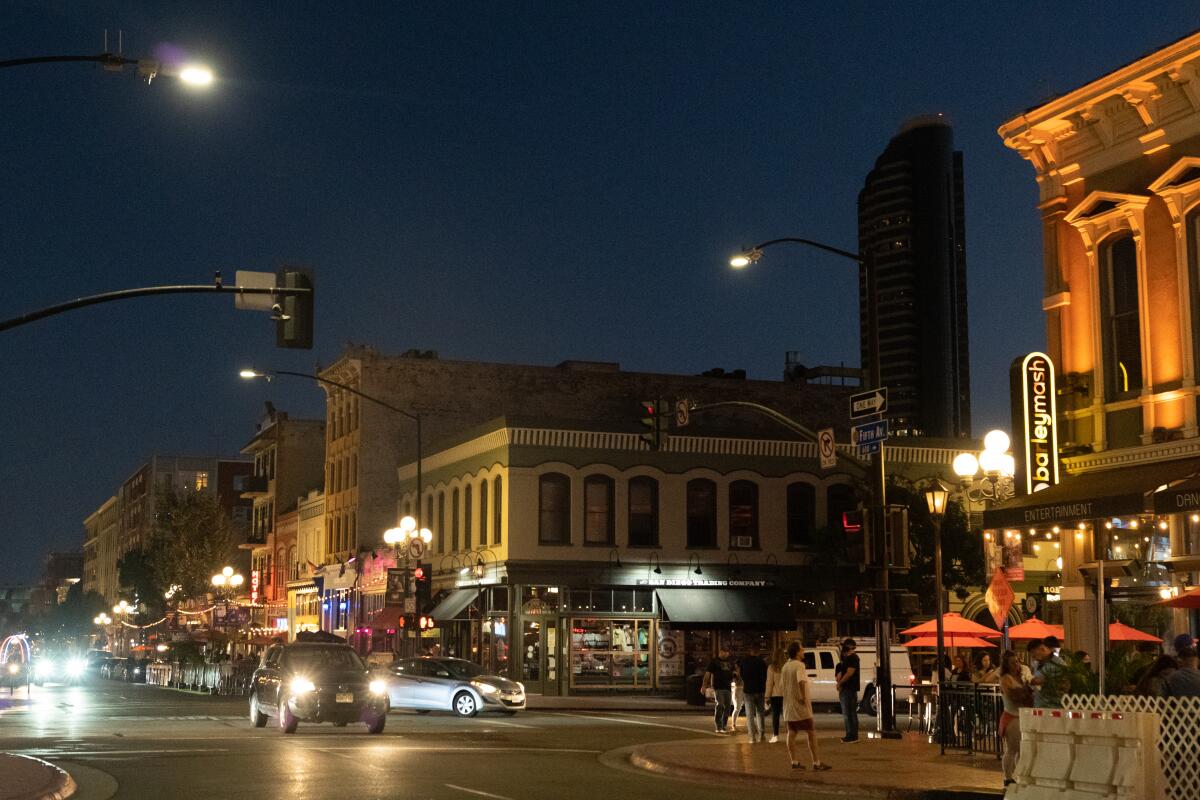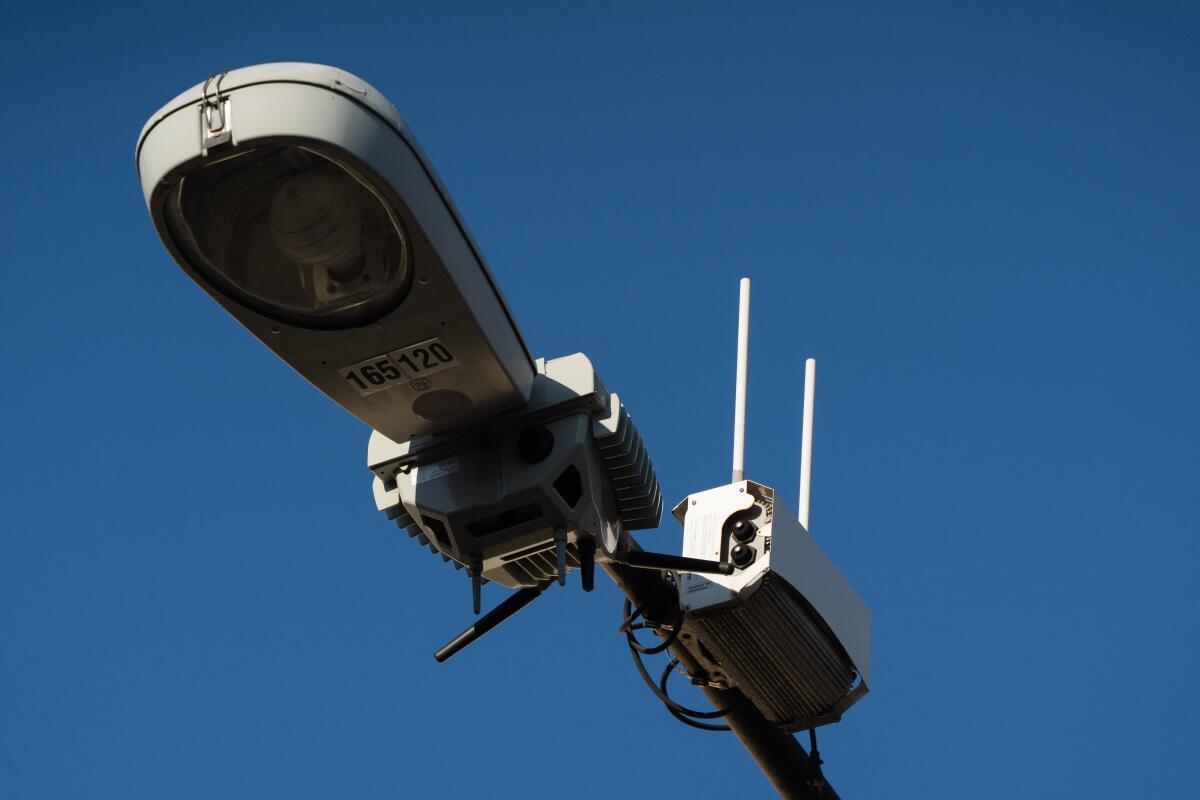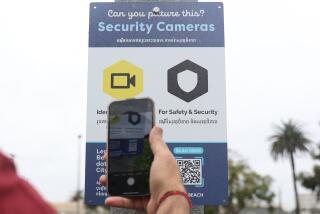San Diego police say now is the time for ‘smart’ cameras; others ask why the rush?

SAN DIEGO — In a few short weeks, the San Diego City Council could be faced with a decision: whether to spend millions of dollars to outfit a network of streetlights with sophisticated surveillance tools.
They’ve said yes before.
In 2016, council members signed off on a $30-million project that pledged to use energy-saving Smart Streetlights to assess traffic and parking patterns throughout the city. What the public didn’t know — and wouldn’t know for years — is that the technology came with cameras that could be accessed by police.
This story is for subscribers
We offer subscribers exclusive access to our best journalism.
Thank you for your support.
The resulting outcry — based on concerns about privacy and equity — led San Diego to shut down the network and fueled the creation of a surveillance ordinance that would govern the use of Smart Streetlights and similar technologies.
And now those new rules will be put to the test.
On Wednesday, the San Diego Police Department proposed installing 500 new Smart Streetlights, complete with cameras that double as automatic license plate readers. If the plan goes forward, the city would become the largest in the country to use cameras and plate readers as part of a single network, police officials said.
The city launched a detailed web page outlining what the streetlights could and could not do, proposed policies governing how the technology would be used as well as information on where the cameras would be installed.

Officials also set up community meetings to solicit feedback on the proposal — all before a single streetlight would be outfitted.
“I share the general public’s skepticism about technology, particularly when you’re not being direct with them about what you have, why you have it and what you’re going to use it for,” San Diego Mayor Todd Gloria said in an interview last week.
“What I’m heartened by is we do get to ask these questions,” he said. “We will provide answers, and we’ll do it before we acquire or deploy this technology. I feel passionately about this issue, as passionately as I feel that [these streetlights] will be good for our city and will keep more people safe.”
The approach is markedly different, and apparently more transparent, than when the Smart Streetlights were first installed, but community groups still worry the process is being rushed.
Lilly Irani, an associate UC San Diego professor who specializes in technology ethics, is part of the coalition that helped craft the city’s new surveillance ordinances. She said the community needs more time to look into the technology the city wants to use to more fully understand what it does and who would be impacted.
Public input meetings were announced just a few days ago, and will be held this Monday through Friday. The following week, on March 15, the plan will go to the city’s Privacy Advisory Board.
That fast turn-around, Irani said, does not give the department time to evaluate the feedback community members provide or potentially make changes to its proposal.
“It looks like you’re trying to jam a new technology through while checking off the checkboxes of the surveillance ordinances,” Irani said.
“If you’re going to install this system that you’re going to be using in the city for the next decade or the next 100 years, isn’t six months worth it?” she said.
Experts have long criticized surveillance technologies for disproportionately impacting Black and brown communities.
A Union-Tribune analysis of the proposed locations found that more than a fifth of the streetlights would be placed in San Diego’s District 8, which is more than 70% Latino and includes communities like Barrio Logan, Logan Heights, Otay Mesa and San Ysidro. The district would see about eight cameras per 10,000 people, a rate that’s nearly double that of some other districts.
How high-tech streetlights work
The high-tech streetlights San Diego is looking to install are produced by Ubicquia, a telecommunications company headquartered in Fort Lauderdale, Fla.
The streetlight platform comes with a host of features, according to the company’s website, including cameras and dual-directional microphones. The product can be outfitted with different software packages.
It’s up to the city to pick which features it uses.
San Diego police Capt. Jeff Jordon said the department plans to use the cameras to record footage in public spaces where people don’t have a reasonable expectation of privacy.
The department also wants to add automated license plate reader technology to the lights. The tool would capture the plates of vehicles as they pass by, note when and where they were seen, and then run that information against a variety of law enforcement databases.
The databases contain information about vehicles that may have a connection to missing-person cases or crimes like car thefts. Some of the databases are used by law enforcement agencies across the country, while others are produced by departments nearby. San Diego can also build its own watch lists as crimes and other incidents happen.
If the system picks up on a vehicle suspected in an incident, that information is sent to the department’s communication center, which relays the information to officers.
Jordon said the camera footage would not be monitored in real time, but instead accessed to investigate serious crimes or incidents.
Police and city officials praised the tools for their effectiveness, and cited their impact on police work as the reason for pursuing their installation.
“These two technologies together provide a tremendous ability to immediately impact our ability to focus resources, investigate crimes, and successfully prosecute and hold people accountable who commit those crimes,” Jordon said.
Between August 2018 and September 2020, the department used footage from Smart Streetlights to investigate hundreds of cases, including 56 homicides or attempted homicides, 55 robberies or burglaries and 55 assaults involving a weapon.
The ones installed in San Ysidro helped investigators zero in on a suspected gunman in the Nov. 6, 2019, shootings of three Church’s Chicken workers, one of whom was killed.
In downtown San Diego, they helped identify a man suspected of donning a costume mask and fatally shooting a business owner in October 2018.
Police officials also accessed streetlights 35 times to gather evidence against demonstrators suspected of committing crimes during protests held in the wake of George Floyd’s murder in 2020— a practice officials said last week would continue.
The department wants to start with 500 streetlights, and posted a map of the proposed locations. The technology would be placed around the city, from Carmel Mountain Ranch to San Ysidro. Many of the locations are near freeways and along main thoroughfares.
Proposed locations for Smart Streetlights and automated license plate readers
The San Diego Police Department has proposed re-installing Smart Streetlights and adding automated license plate readers at 500 locations across the city. Many are located near freeways and other main thoroughfares.
Zoom in to find your neighborhood.
Jordon said the department used crime data and input from investigators to choose where the cameras should go.
Under the proposed plan, District 8 would contain 111 of the streetlights, the most of any district. In addition to being largely Latino, nearly half of the district’s households earn less than $45,000 a year, according to estimates from the San Diego Association of Governments.
Councilmember Vivian Moreno, who oversees District 8, did not immediately reply to requests for comment about the placements.
Another 91 cameras will be placed in District 3, which encompasses Hillcrest, North Park and downtown San Diego. That’s a rate of about four cameras per 10,000 people.
The district is about 55% white, 29% Latino, 7% Asian and 5% Black.
Councilmember Stephen Whitburn, who oversees District 3, said in a statement last week that the neighborhoods he represents consistently list public safety as a top priority. He said he thinks the tech helps meet that need.
“When the Smart Streetlights were active, they helped solve crimes and got criminals off the streets,” he said.
What about privacy?
Although police and city leaders stress that technologies like license plate readers are collecting anonymous data — meaning it does not contain personally identifiable information — privacy advocates argue that what’s actually being gathered is location data.
And that’s personal stuff.
Dave Maass, director of investigations for the Electronic Frontier Foundation, a digital rights organization, said it would be “intellectually dishonest” to call license plate information anonymous.
“Your location data can provide clues about who you’re dating, what your medical conditions are, how you worship and if you’re engaged in civil protest or city politics,” Maass said. “It’s personal information that can reveal intimate details about your life — information that’s really nobody’s business but your own.”
Although the Police Department’s proposed policy provides guidance about how and when to use the technology, investigators still have plenty of discretion.
They need to have a “legitimate law enforcement purpose” to access license plate data or to enter a license plate into the system, according to the department’s proposed policy. Those legitimate purposes can include everything from locating vehicles wanted in connection with a crime to “confirming parking enforcement violations.”
The policy also states that neither reasonable suspicion nor probable cause are required to access license plate reader equipment.
The department has said that everyone with access to the system will be specially trained, but the list of those who could gain access is expansive and includes groups like the department’s Retired Senior Volunteer Patrol.
Maass also said the notifications that license plate reader systems send out can sometimes steer departments toward particular types of crimes — and those crimes may not be the same ones communities want officers to focus on.
Jordon said the department will pay close attention to the volume of alerts the system generates, and is prepared to alter course if necessary.
For more information about the technology and the community meetings being held to discuss it, visit the city’s website.
More to Read
Sign up for Essential California
The most important California stories and recommendations in your inbox every morning.
You may occasionally receive promotional content from the Los Angeles Times.












